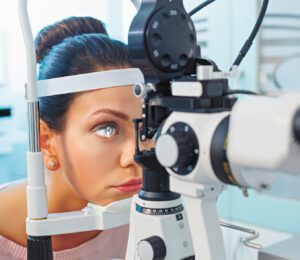 Thanks to cutting-edge technology, modern eye care is evolving from traditional eye exams — leading to better results and an overall improved experience for patients. Here’s how the role of technology can improve your visual health, both in and out of the optometrist’s office.
Thanks to cutting-edge technology, modern eye care is evolving from traditional eye exams — leading to better results and an overall improved experience for patients. Here’s how the role of technology can improve your visual health, both in and out of the optometrist’s office.
HOW TECHNOLOGY HAS IMPACTED MODERN EYE CARE
For a long time, traditional eye exams relied on low-tech methods. Eye charts and handheld instruments were the main tests that helped determine your prescription and overall eye health. To see your retina, optometrists often have to dilate the eyes, leading to a delayed recovery time after appointments. Today, modern eye care is much more effective and efficient, leading to better and faster results. Some of the main improvements technology has made in modern eye care include:
. Improved Accuracy: Digital imaging and diagnostic tools allow for a more holistic eye exam that can notice more minute changes than traditional tools. This leads to earlier detection of serious eye conditions, including glaucoma, macular degeneration and diabetic retinopathy.
. Personalized Care: With advanced diagnostics, optometrists and ophthalmologists can help lay out a detailed plan that’s suited exactly to their patient’s needs. Instead of a one-size-fits-all approach, vision correction plans can be tailored to specific requirements.
. More Treatment Options: Some advanced treatment options, such as LASIK, wouldn’t be possible without advanced technology. These procedures can greatly help improve vision and overall quality of life. LASIK consultations can take just a few minutes, providing a proactive step forward into these advanced treatments.
. Streamlined Care Process: Automated tools and other advanced technologies can streamline the eye exam process, reducing wait times and creating a more comfortable patient experience.
USING TECHNOLOGY TO MODERNIZE EYE CARE
Not all technology has to be advanced to improve patient care. Telemedicine, for example, has become increasingly popular for general practitioners and other forms of medicine over the past few years, and it’s beginning to make its way into optometry. The American Optometric Association sees telemedicine as a benefit, allowing optometrists to expand their reach to patients who can’t come to the office. Telemedicine helps practices manage their resources while providing more access to harder-to-reach individuals. It’s also a more convenient option for people who may not have time to come into a traditional optometry office.
Artificial intelligence (AI) is also making its way into optometry. AI systems can help improve appointment scheduling, and it can also conduct fast data entry, analysis and retrieval.
Some optometry offices are using AI for note-taking during appointments, providing a summary analysis of the appointment that’s beneficial for both the patient and the doctor. AI is also being used to evaluate and analyze diagnostic images, which can lead to a quick and accurate diagnosis.
GET ADVANCED MODERN EYE CARE AT LAKE EYE
Modern eye care isn’t just a thing of the future – it’s an industry standard. Fortunately, the experts at Lake Eye are equipped with the latest technology to provide you with comprehensive eye health services.
From full-service eye exams in our optical department to advanced surgical treatments for nearly every eye condition, Lake Eye, a US Eye Company, is dedicated to preserving and restoring your vision. To learn more about the variety of services we provide to help protect your sight as well as slow and reverse vision loss, contact us to schedule an appointment with one of our experts.
Lake Eye Associates
352-632-2020 • LakeEye.com
 Central Florida Health and Wellness Magazine Health and Wellness Articles of the Villages
Central Florida Health and Wellness Magazine Health and Wellness Articles of the Villages



